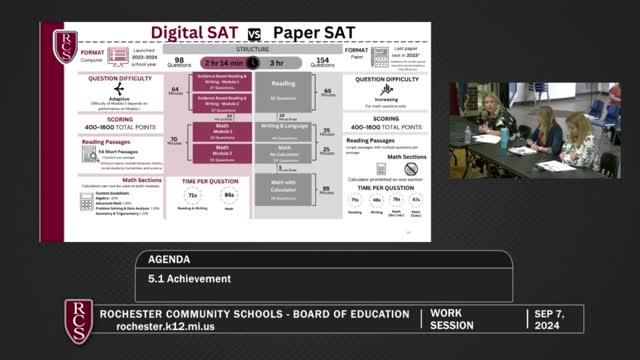College Board reveals major changes to SAT testing format
October 07, 2024 | Rochester Community School District, School Boards, Michigan
This article was created by AI summarizing key points discussed. AI makes mistakes, so for full details and context, please refer to the video of the full meeting. Please report any errors so we can fix them. Report an error »

In a recent government meeting, significant changes to the SAT testing format were discussed, highlighting a shift towards a more adaptive and individualized assessment approach. The College Board's new digital SAT includes two modules for both evidence-based reading and writing, as well as math, where students' performance in the first module directly influences the difficulty of questions in the second module. This adaptive testing model allows for a tailored experience, contrasting with the previous paper format where all students faced the same set of questions.
The English section has undergone a notable transformation, merging reading and writing components into a single, integrated format. Previously, students encountered lengthy passages followed by multiple-choice questions; now, they will engage with shorter passages, each followed by a single question. This change aims to assess students' skills more dynamically, although the complexity of the questions may have increased despite the brevity of the passages.
In the math section, another major update allows calculators throughout the entire test, including the use of a built-in Desmos graphing calculator. This shift emphasizes conceptual understanding and application over rote memorization, encouraging students to utilize various representations, such as graphs and tables, to solve problems.
Overall, these changes reflect a significant evolution in the SAT's design, aiming to enhance accessibility and better evaluate students' skills in a modern educational context.
The English section has undergone a notable transformation, merging reading and writing components into a single, integrated format. Previously, students encountered lengthy passages followed by multiple-choice questions; now, they will engage with shorter passages, each followed by a single question. This change aims to assess students' skills more dynamically, although the complexity of the questions may have increased despite the brevity of the passages.
In the math section, another major update allows calculators throughout the entire test, including the use of a built-in Desmos graphing calculator. This shift emphasizes conceptual understanding and application over rote memorization, encouraging students to utilize various representations, such as graphs and tables, to solve problems.
Overall, these changes reflect a significant evolution in the SAT's design, aiming to enhance accessibility and better evaluate students' skills in a modern educational context.
View full meeting
This article is based on a recent meeting—watch the full video and explore the complete transcript for deeper insights into the discussion.
View full meeting
